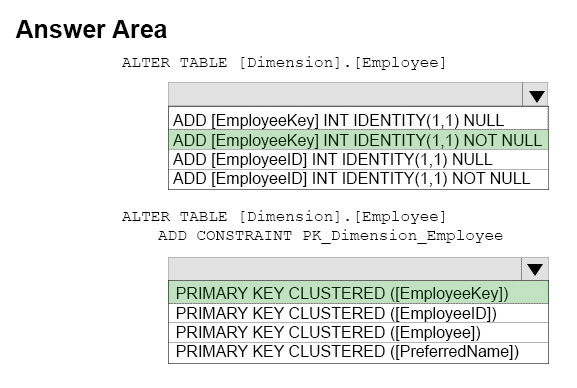Microsoft 70-767 Exam Practice Questions (P. 5)
- Full Access (142 questions)
- Six months of Premium Access
- Access to one million comments
- Seamless ChatGPT Integration
- Ability to download PDF files
- Anki Flashcard files for revision
- No Captcha & No AdSense
- Advanced Exam Configuration
Question #21
HOTSPOT -
Your company has a Microsoft SQL Server data warehouse instance. The human resources department assigns all employees a unique identifier. You plan to store this identifier in a new table named Employee.
You create a new dimension to store information about employees by running the following Transact-SQL statement:
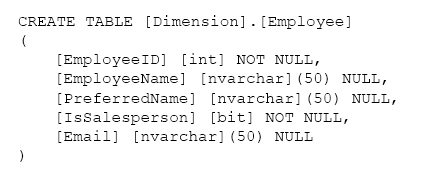
You have not added data to the dimension yet. You need to modify the dimension to implement a new column named [EmployeeKey]. The new column must use unique values.
How should you complete the Transact-SQL statements? To answer, select the appropriate Transact-SQL segments in the answer area.
Hot Area:
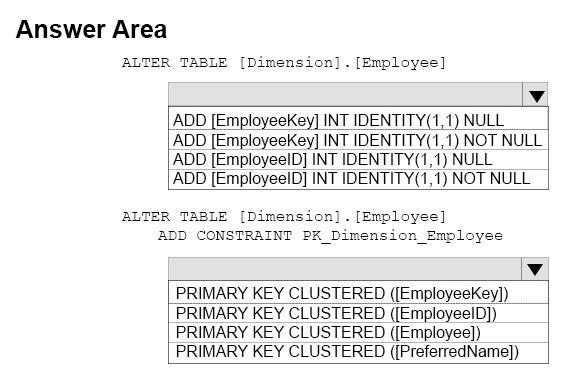
Your company has a Microsoft SQL Server data warehouse instance. The human resources department assigns all employees a unique identifier. You plan to store this identifier in a new table named Employee.
You create a new dimension to store information about employees by running the following Transact-SQL statement:

You have not added data to the dimension yet. You need to modify the dimension to implement a new column named [EmployeeKey]. The new column must use unique values.
How should you complete the Transact-SQL statements? To answer, select the appropriate Transact-SQL segments in the answer area.
Hot Area:

send
light_mode
delete
Question #22
HOTSPOT -
You deploy a Microsoft Azure SQL Data Warehouse instance. The instance must be available eight hours each day.
You need to pause Azure resources when they are not in use to reduce costs.
What will be the impact of pausing resources? To answer, select the appropriate options in the answer area.
NOTE: Each correct selection is worth one point.
Hot Area:
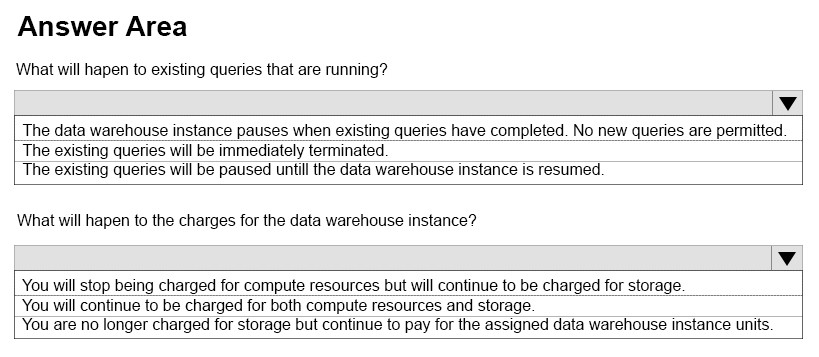
You deploy a Microsoft Azure SQL Data Warehouse instance. The instance must be available eight hours each day.
You need to pause Azure resources when they are not in use to reduce costs.
What will be the impact of pausing resources? To answer, select the appropriate options in the answer area.
NOTE: Each correct selection is worth one point.
Hot Area:

Correct Answer:
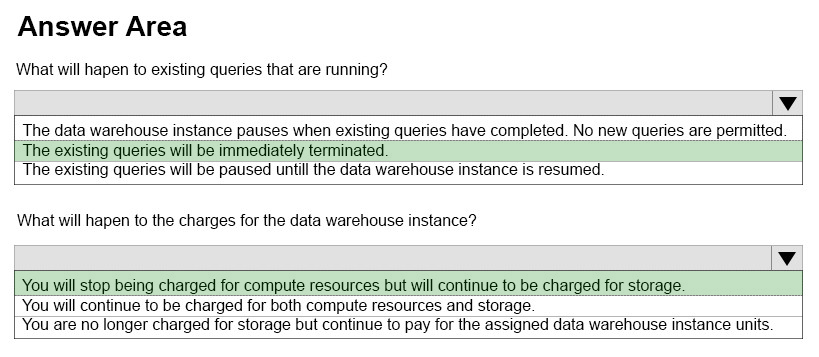
To save costs, you can pause and resume compute resources on-demand. For example, if you won't be using the database during the night and on weekends, you can pause it during those times, and resume it during the day. You won't be charged for DWUs while the database is paused.
When you pause a database:
Compute and memory resources are returned to the pool of available resources in the data center
Data Warehouse Unit (DWU) costs are zero for the duration of the pause.
Data storage is not affected and your data stays intact.
SQL Data Warehouse cancels all running or queued operations.
When you resume a database:
SQL Data Warehouse acquires compute and memory resources for your DWU setting.
Compute charges for your DWUs resume.
Your data will be available.
You will need to restart your workload queries.
References: https://docs.microsoft.com/en-us/azure/sql-data-warehouse/sql-data-warehouse-manage-compute-rest-api

To save costs, you can pause and resume compute resources on-demand. For example, if you won't be using the database during the night and on weekends, you can pause it during those times, and resume it during the day. You won't be charged for DWUs while the database is paused.
When you pause a database:
Compute and memory resources are returned to the pool of available resources in the data center
Data Warehouse Unit (DWU) costs are zero for the duration of the pause.
Data storage is not affected and your data stays intact.
SQL Data Warehouse cancels all running or queued operations.
When you resume a database:
SQL Data Warehouse acquires compute and memory resources for your DWU setting.
Compute charges for your DWUs resume.
Your data will be available.
You will need to restart your workload queries.
References: https://docs.microsoft.com/en-us/azure/sql-data-warehouse/sql-data-warehouse-manage-compute-rest-api
send
light_mode
delete
Question #23
HOTSPOT -
You have a Microsoft SQL Server Data Warehouse instance that uses SQL Server Analysis Services (SSAS). The instance has a cube containing data from an on-premises SQL Server instance. A measure named Measure1 is configured to calculate the average of a column.
You plan to change Measure1 to a full additive measure and create a new measure named Measure2 that evaluates data based on the first populated row.
You need to configure the measures.
What should you do? To answer, select the appropriate options in the answer area.
NOTE: Each correct selection is worth one point.
Hot Area:
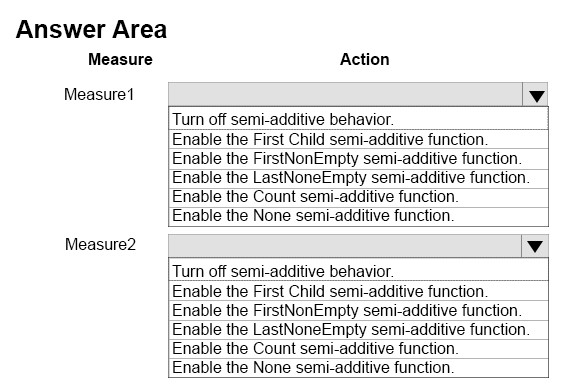
You have a Microsoft SQL Server Data Warehouse instance that uses SQL Server Analysis Services (SSAS). The instance has a cube containing data from an on-premises SQL Server instance. A measure named Measure1 is configured to calculate the average of a column.
You plan to change Measure1 to a full additive measure and create a new measure named Measure2 that evaluates data based on the first populated row.
You need to configure the measures.
What should you do? To answer, select the appropriate options in the answer area.
NOTE: Each correct selection is worth one point.
Hot Area:

Correct Answer:
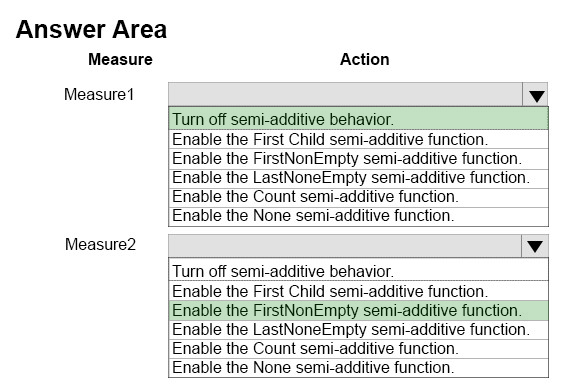
Box 1:
The default setting is SUM (fully additive).
Box 2:
FirstNonEmpty: The member value is evaluated as the value of its first child along the time dimension that contains data.
References: https://docs.microsoft.com/en-us/sql/analysis-services/multidimensional-models/define-semiadditive-behavior

Box 1:
The default setting is SUM (fully additive).
Box 2:
FirstNonEmpty: The member value is evaluated as the value of its first child along the time dimension that contains data.
References: https://docs.microsoft.com/en-us/sql/analysis-services/multidimensional-models/define-semiadditive-behavior
send
light_mode
delete
Question #24
Note: This question is part of a series of questions that use the same or similar answer choices. An answer choice may be correct for more than one question in the series. Each question is independent of the other questions in this series. Information and details provided in a question apply only to that question.
You are a database administrator for an e-commerce company that runs an online store. The company has three databases as described in the following table.

You plan to load at least one million rows of data each night from DB1 into the OnlineOrder table. You must load data into the correct partitions using a parallel process.
You create 24 Data Flow tasks. You must place the tasks into a component to allow parallel load. After all of the load processes compete, the process must proceed to the next task.
You need to load the data for the OnlineOrder table.
What should you use?
You are a database administrator for an e-commerce company that runs an online store. The company has three databases as described in the following table.

You plan to load at least one million rows of data each night from DB1 into the OnlineOrder table. You must load data into the correct partitions using a parallel process.
You create 24 Data Flow tasks. You must place the tasks into a component to allow parallel load. After all of the load processes compete, the process must proceed to the next task.
You need to load the data for the OnlineOrder table.
What should you use?
- ALookup transformation
- BMerge transformation
- CMerge Join transformation
- DMERGE statement
- EUnion All transformation
- FBalanced Data Distributor transformation
- GSequential container
- HForeach Loop container
Correct Answer:
H
The Parallel Loop Task is an SSIS Control Flow task, which can execute multiple iterations of the standard Foreach Loop Container concurrently.
References: http://www.cozyroc.com/ssis/parallel-loop-task
H
The Parallel Loop Task is an SSIS Control Flow task, which can execute multiple iterations of the standard Foreach Loop Container concurrently.
References: http://www.cozyroc.com/ssis/parallel-loop-task
send
light_mode
delete
Question #25
Note: This question is part of a series of questions that use the same or similar answer choices. An answer choice may be correct for more than one question in the series. Each question is independent of the other questions in this series. Information and details provided in a question apply only to that question.
You are a database administrator for an e-commerce company that runs an online store. The company has the databases described in the following table.

Each day, you publish a Microsoft Excel workbook that contains a list of product names and current prices to an external website. Suppliers update pricing information in the workbook. Each supplier saves the workbook with a unique name.
Each night, the Products table is deleted and refreshed from MDS by using a Microsoft SQL Server Integration Services (SSIS) package. All files must be loaded in sequence.
You need to add a data flow in an SSIS package to perform the Excel files import in the data warehouse.
What should you use?
You are a database administrator for an e-commerce company that runs an online store. The company has the databases described in the following table.

Each day, you publish a Microsoft Excel workbook that contains a list of product names and current prices to an external website. Suppliers update pricing information in the workbook. Each supplier saves the workbook with a unique name.
Each night, the Products table is deleted and refreshed from MDS by using a Microsoft SQL Server Integration Services (SSIS) package. All files must be loaded in sequence.
You need to add a data flow in an SSIS package to perform the Excel files import in the data warehouse.
What should you use?
- ALookup transformation
- BMerge transformation
- CMerge Join transformation
- DMERGE statement
- EUnion All transformation
- FBalanced Data Distributor transformation
- GSequential container
- HForeach Loop container
Correct Answer:
A
If you're familiar with SSIS and don't want to run the SQL Server Import and Export Wizard, create an SSIS package that uses the Excel Source and the SQL
Server Destination in the data flow.
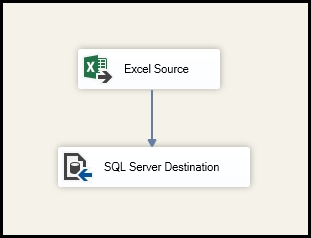
References: https://docs.microsoft.com/en-us/sql/integration-services/import-export-data/import-data-from-excel-to-sql
A
If you're familiar with SSIS and don't want to run the SQL Server Import and Export Wizard, create an SSIS package that uses the Excel Source and the SQL
Server Destination in the data flow.

References: https://docs.microsoft.com/en-us/sql/integration-services/import-export-data/import-data-from-excel-to-sql
send
light_mode
delete
All Pages

